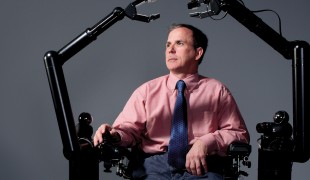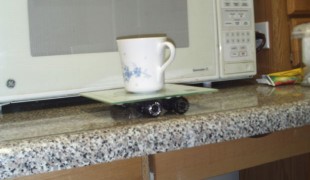- 3438
- 192
- 6
- 8
- 0
- Help Ukraine
About the solution
The bane of a person in a wheelchair is picking things up they dropped on the floor. Over the next week or so I would like to share some of the simple devices I come up with to help pick up a variety of objects.
It first happened when I was alone and had dropped a piece of paper on the floor. I quickly realized this was a challenge I had to solve. The procedure I use was developed, as were most of my creations, with much frustration, failure and trial and error, but it is now quite a reliable method for me to use. As time went on I added accessories which increase the function of the tool itself.
To pick up a piece of paper on the floor get a thin, flat washer, which is fairly large, and drop it on the floor near the piece of paper. Use a telescoping Mega-Mag Magnetic Pick-Up Tool which cost about $15 at Sears, in the States, to slide the piece of paper over the washer. Then, using the magnet pick up the paper with the washer underneath it. I made modifications to the handle of the magnet, not only to make it easier to use, but also for it to be more functional. I took a loop of Velcro and taped it onto the handle with electrical tape both eliminating my problem of poor grip and also allowing me to pick up some cloth items with the Velcro. When the Velcro on the handle became less effective I placed a patch of the "hook" side of Velcro on a flat washer and now that can be used to pick up some cloth items. As I continued to use the Mega-Mag Magnetic I began to think a large piece of flat metal would be quite functional. I had a friend cut a pan of metal out that was 5” x 6”. The large pan worked very well. Place the pan on an angle and slide it under what you want to pick up. It can also be used to pick up dropped DVD and many other objects. The larger area makes the task much easier.
I am constantly revisiting the tools that I have made to see if they can be improved. A while ago, one edge of the metal pan was turned up to prevent objects from rolling or sliding off. I have also taped flat washers to plastic items enabling their pickup with the magnet. A new or used electrode can be fastened to a washer using a piece of two way tape. This setup will pick up many light weight objects. A metal flashlight has also been added to my accessories. These modifications make the Pick Up tool even more versatile.
This solution shall not include mention to the use of drugs, chemicals or biologicals (including food); invasive devices; offensive, commercial or inherently dangerous content. This solution was not medically validated. Proceed with caution! If you have any doubts, please consult with a health professional.
-
-
309
-
0
-
5616

Paralyzed man designs innovative wheelchairs
CAREGIVING
MOVING IN A WHEELCHAIR: Moving using a wheelchair.
Grip
Rubgy
Basketball
Paralysis
Cervical spinal cord injury/Tetraplegia
Assistive Daily Life Device (to help ADL)
Assistive Technology access
Walking Aid (wheelchair/walker/crutches)
Restoring mobility
Replacing lost limbs
Promoting self-management
Promoting inclusivity and social integration
Recovering from Traumatic Injuries
Preventing (Vaccination, Protection, Falls, Research/Mapping)
Caregiving Support
Neurology
Orthopedics
Physical Medicine and Rehabilitation
United States
-
-
-
343
-
3
-
5705

Transfer board
-
-
-
310
-
0
-
4176

Hot plate on wheels
-
 en
en